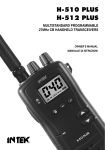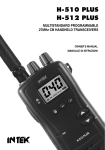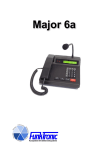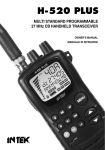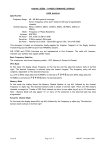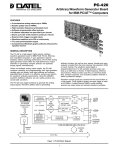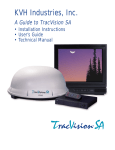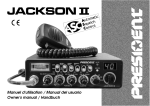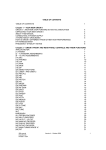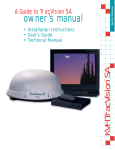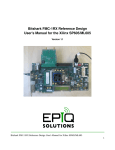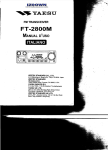Download USER MANUAL HR-2800 DRAFT - K-Po
Transcript
HR-2800 28 MHZ AM-FM AMATEUR RADIO HF TRANSCEIVER OWNER'S MANUAL NOTICE ! It is recommended to carefully read this owner’s manual before using the product. This will also help to prevent illegal use of the radio in violation of the regulations valid in the country where the product is used, as well as to avoid causing possible interferences to other services. Index Introduction - Content of the packaging Controls and operation CTCSS function Installation Specifications - User Information ESP Compander Diagram - CTCSS Diagram PCB - Main Board & CPU Board Diagram Block Diagram 1 1 2-9 10 11 14 II III - IV V - VI VII-VIII NOTICE ! This transceiver has been factory programmed, in order to use the product immediately after purchase. The programming includes the activation of frequencies in the HF 10 Meter Amateur Band, according to the technical rules in force for the use of this bands. The manufacturer is not responsible for any modification to the harware or software of the product, which may possibly cause the radio Congratulations ! Congratulations for selecting and purchasing a K-PO quality product. K-PO HR-2800 is a 10-Meter band Amateur Radio transceiver using advanced hardware and software design. This transceiver includes a number of advanced functions and systems, therefore it is definitely necessary to carefully read this owner’s manual before using the radio. With a correct use of the product in accordance with the operating method described in this manual, the product will offer a trouble free use for many years. K-PO is constantly engaged to develop and provide quality products meeting the customers requirements, however any suggestion or comments on this product that might help us to improve quality are warmly welcome. Content of the packaging Please check that all the following items are contained in the packaging : • • • • • • • Main unit (transceiver) DC power cord with fuse holder and fuse Dynamic microphone Car mounting bracket Car mounting bracket accessories (hardware, knobs, etc.) Microphone bracket Owner’s manual Front panel 1. ANL-OFF Selector This selector enables the ANL function (Automatic Noise Limiter). The ANL reduces electric and electromagnetic noise on the operating frequency. Move the selector to ANL to enable the Automatic Noise Limiter and move it to OFF to disable it. 2. LOC-DX Selector This selector enables the LOC function (Local), in order to attenuate the strength of the incoming signals. The attenuator is useful in case of very strong incoming signals from local stations that, due to the high signal level, might cause distortion and poor quality of the received signals. Move the selector to the DX (Long Distance) when receiving weak signals or from long distance. Move the selector to LOC (Local) when receiving strong signals from local stations. 3. LCD Display Large size (visible area mm 54 x 21) LCD display with orange colour backlighting system, for best readability. The LCD display shows all the enabled functions as well as several other information and user programmable functions, like the full 5-digit frequency readout. LCD also includes a digital 10-bar S/RF Meter to monitor the strength/power of the received and transmitted signals. LCD Display A. AM Icon The AM icon is lighted when radio receives and transmits in AM mode (amplitude modulation). B. FM Icon The FM icon is lighted when radio receives and transmits in FM mode (frequency modulation). C. SCAN Icon The SCAN icon is lighted when the SCAN function (automatic search of busy frequencies) is enabled. D. TRUCK Icon The TRUCK icon is lighted when the special programmable TRUCK memory channel (for truck drivers) has been selected. E. EMG Icon The EMG icon is lighted when one of the special quick access frequencies has been selected. F. ESP C E Icon The ESP C E icon is lighted when one of the ESP (Electronic Speech Processor) functions has been enabled. The ESP is an RX & TX electronic modulation processor. G. RX Icon The RX icon is lighted when radio is in receive mode. H. TX Icon The TX icon is lighted when radio is in transmit mode. I. DW Icon The DW icon is lighted when the DUAL WATCH function (automatic monitoring of two frequencies) is enabled. L. S/RF Digital Meter A digital 10-bar S/RF METER indicates the strength of the received signal (from S0 to S9+30) in the receive mode and the transmitter RF output power (0 to 20W) in the transmit mode. M. Alphanumeric Digit This alphanumeric digit indicates the fifth and last figure (in KHz) of the operating frequency. N. LOW Icon The LOW icon is lighted when the transmitter is in the LOW POWER (1W) mode. O. LOCK Icon The LOCK icon is lighted when the LOCK function is enabled. P. M1-M4 Icons The M1-M4 icon is lighted when one of the four user programmable memory channels has been selected. Q. Alphanumeric Digit These four numeric or alphanumeric digits indicate : the first four figures of the operating frequency (in KHz). the selected CTCSS code number R. F Icon The F icon is lighted when the F (Function) mode is enabled, which allows the use of the dual function keys (keys 6, 7, 8, 9, 10, 14). 4. ESP Indicator This LED indicator lights up in red colour when the ESP (Electronic Speech Processor) function is enabled. The ESP is an RX & TX electronic modulation processor. 5. TX/RX Indicator This green-red dual colour LED indicator lights up in green colour when radio is in receive mode and in red colour when radio is in transmit mode. 6. AM/FM and M1 Key This key selects the AM or FM operating mode in both RX and TX modes. This key is also used to program and select the memory channel M1 (refer to item .11). 7. SCAN and M2 Key By pressing the SCAN key, the SCAN (automatic scanning of busy frequencies) function is enabled. To enable the SCAN function, first turn the SQUELCH control (19) clockwise, until the background noise is cut. Then press the SCAN key, radio will automatically start scanning all frequencies continuously and the SCAN icon (C) will appear on the LCD. Auto-scan stops if a signal is detected, in order to let the user listen to the incoming signal, auto-scan will start again when no signal is detected on that frequency. If the PTT Key (27) is pressed within 5 seconds, radio will remain on that frequency, otherwise scanning will start again. Auto-scan may be also re-started at any time by pressing again the SCAN key. To exit the SCAN mode, shortly press the PTT button (27). This key is also used to program and select the memory frequency M2 (refer to item .11). 8. LCR and M3 Key By pressing the LCR (Last Channel Recall) key, radio will automatically select the last used frequency. This key is also used to program and select the memory frequency M3 (refer to item .11). 9. DW and M4 Key The DW (Dual Watch) function allows automatic alternate monitoring of two programmable frequencies. Set the first frequency to be frequency to be monitored using the CHANNEL selector (13) or the frequency selection keys on the microphone (28, 30). To enable the DW function, press the DW key for about 2 seconds, until the DW icon (I) appears and blinks on the LCD display. Now set the second frequency to monitor using the CHANNEL selector (13) or the frequency selection keys on the microphone (28, 30). Press again the DW key for about 2 seconds. The DW function is now enabled and the LCD display will alternately show the two programmed frequencies. The DW icon (I) will be lighted on the LCD display. Monitoring stops if a signal is detected on one of the two frequencies, in order to let the user listen to the incoming signal and will start again when no signal is detected on that frequency. It is possible to transmit on that channel, by simply pressing the PTT key (27). If there is no transmission within 5 seconds, monitoring will re-start. To exit the DW mode, shortly press the PTT button (27). This key is also used to program and select the memory frequency M4 (refer to item .11). 10. TRUCK / ROGER BEEP Key The TRUCK key is an exclusive memory function. This key allows quick access to a special programmed memory channel (i.e. an emergency frequency, a favorite frequency, etc.). To program the TRUCK memory frequency, set the desired frequency using the CHANNEL selector (13) or the frequency selection keys on the microphone (28, 30). Then press and hold the TRUCK key until the TRUCK icon (D) appears on the LCD display. The TRUCK frequency is now stored in the special TRUCK memory and it can be immediately re-called by simply pressing the TRUCK key (10). This key is also used to enable the Roger Beep function (refer to item .11). 11. F (Function) Key The F (Function) key is used to enable various functions. MEMORY FREQUENCIES (M1-M4) PROGRAMMING Set the frequency to be programmed and stored in one of the four available memories (M1-M4), using the CHANNEL selector (13) or the frequency selection keys on the microphone (28, 30). Shortly press the F key and the F icon (C) will blink on the LCD display. Now press and hold one of the memory keys M1, M2, M3 or M4 for about 2 seconds, until the memory frequency number will appear on the LCD display (i.e. M1). All the specifications associated to each frequency will be stored in memory (i.e. AM/FM mode, EU/UK mode, transmitter power, CTCSStone, etc.). MEMORY FREQUENCIES (M1-M4) SELECTION Shortly press the F key and the F icon (R) will blink on the LCD display. Now press one of the dual function keys (M1 to M4) to quickly recall and access to one of the programmed memory frequencies. The selected memory frequency number will appear on the LCD display (P). CTCSS TONE SELECTION Please see the CTCSS section at page. 10. ROGERBEEP FUNCTION To enable or disable the RB (Roger Beep Tone), shortly press the F key (11) and the F icon ® on the LCD will blink. Now press the TRUCK key (10). The Rb.on icon (RB enabled) or the Rb.oFF icon (RB disabled) will be showed on the LCD. 12. Q.DN (Quick Down) Key This key allows fast selection of the operating frequency downward. Each time this key is pressed, the frequency number moves down by 100 KHz steps. 13. CHANNEL (FREQUENCY) Selector This knob selects the desired frequency, in 5 KHz steps (frequency increments). The knob may be turned clockwise to upward frequency selection or counter clockwise to downward frequency selection. 14. EMG Key EMG Press to quick access to one of the two pre-programmed special frequencies (28.500 MHz or 29.000 MHz). Each time this key is pressed, radio will select the frequency of 28.500 MHz, then 29.000 MHz, then again the normal operating frequency. When one of the special frequency is selected, the EMG icon (E) will appear on the LCD display. CTCSS FUNCTION To access the CTCSS (sub-audible tone coding) function (see the CTCSS section at page 10), shortly press the F key (11) and then the EMG key (14). 15. ESP (Electronic Speech Processor) Key The ESP (Electronic Speech Processor) is a unique feature available in some INTEK two-way radios. ESP means Electronic Speech Processor, in other words electronic modulation processor. This audio processor is microprocessor controlled and it is also called COMPANDER (Compressor-Expander). It works as a modulation compressor in transmit mode and as a modulation expander in receive mode. The ESP allows to obtain a stronger, clear and clean audio signal and it is a great help in noisy areas and in case of weak signals or in long distance communication. The efficiency of ESP is even greater when both stations use this device. The 2nd generation ESP allows to enable only the TX compressor, only the RX expander or both systems. To enable or disable the ESP functions, press the ESP key (4), as follows : 1) Press the key once to enable the TX modulation compressor. The ESP C (F) icon will appear on the LCD. 2) Press the key again to enable the RX modulation expander. The ESP E (F) icon will appear on the LCD. 3) Press the key again to enable both the TX modulation compressor and the RX modulation expander. The ESP C E (F) icon will appear on the LCD. 4) Press the key once again to disable all systems. ESP performance of the modulation in RX and TX modes Modulation without ESP Modulation with ESP 16. MIC GAIN Control This transceiver uses a high quality dynamic microphone. The microphone gain is adjustable with the MIC GAIN control. By turning the knob clockwise, the microphone gain is increased. 17. Q.UP (Quick UP) Key This key allows fast selection of the operating frequency upward. Each time this key is pressed, the frequency number moves up by 100 KHz steps. 18. PA/RFGAIN Control RF GAIN CONTROL This transceiver uses a high sensitivity and selectivity receiver circuit. The receiver gain is adjustable with the RF GAIN control. By turning the knob clockwise, the receiver gain is increased. It is convenient to reduce the receiver gain in case of very strong signals from local stations and to increase it in case of weak signals or long distance communications. PA CONTROL The radio includes the PA (Public Address) function, in order to spread audio messages through an external speaker. To use the PA function, connect an external speaker (optional) to the PA jack (24) located on the rear side of the radio. Turn the PA/SQL knob completely counter clockwise to the PA position. The PA icon (Q) appears on the LCD display. Now it is possible to press the PTT key (27) and speak into the microphone to spread your message through the external speaker. Adjust the microphone gain with the MIC GAIN knob (16) to the desired level. 19. AS/SQL Control SQUELCH CONTROL (SQUELCH manual adjustment) The SQUELCH control allows to silent the receiver by cutting the background noise, when no signals are received. Turn the knob clockwise until the background noise is cut. Turn the knob counter clockwise (SQUELCH opening) in order to listen to the weakest signals. AS CONTROL (SQUELCH fixed setting) The AS function allows to automatically silent the receiver, avoding the SQUELCH manual adjustment. A fixed SQUELCH threshold is factory pre-set. To enable the fixed SQUELCH function, turn the knob fully counter clockwise to the AS position, until a click noise is heard. 20. OFF/VOL (OFF /Volume) Control This knob switches the radio ON and OFF and it adjusts the volume control. If no signals are being received on the operating frequency, it is suggested to open the SQUELCH and adjust the volume to the desired level while listening to the background noise. 21. MICROPHONE Connector Connect the supplied dynamic microphone to this connector, locking it through the ring nut. Rear Panel 22. ANTENNA Connector Antenna connector. Refer to the section INSTALLATION OF THE ANTENNA. 23. S-METER Jack Connect an external S-METER (optional) to this jack. 24. PA Jack If the PA function has to be used, connect to the external speaker (optional) to this jack. Refer to item no. 19. 25. EXT (External Speaker) Jack This jack is for connecting an external speaker (optional). 26. 13.2VDC / 32VDC POWER CORD 13.2VDC / 32VDC input power cord. Microphone 27. PTT (Push-to-Talk) Key Transmitter key. Press the PTT key to transmit and release it to return to the receive mode. 28. UP (Frequency Selector) Key Each time this key is pressed, the frequency moves 5 KHz upward. 29. LOCK (Keypad Lock) Key The LOCK function is enabled when pressing this key, in order lock the keypad and prevent entering unwanted commands. When the LOCK function is enabled, the LOCK icon (O) appears on the LCD display. 30. DOWN (Frequency Selector) Key Each time this key is pressed, the frequency moves 5 KHz upward. 31. MICROPHONE Plug Connect the 6-pole microphone plug with locking ring nut to the microphone connector (21) located on the front side of the radio. Important ! Do never attempt to open the cabinet of the transceiver. No user serviceable parts inside. Internal modifications or tampering may cause damage to the product, modify its technical specifications and will void warranty rights. If service or repair are required, please refer to an authorised service centre or specialized technician. CTCSS Function 50 CTCSS private codes are available. Different CTCSS tones may be associated to different frequencies, by storing it on the 4 memory frequencies (M1-M4) or on the special TRUCK memory frequency. Therefore up to 5 frequencies may be programmed and stored (M1-M4 + TRUCK) with a CTCSS tone associated. To set the CTCSS function, proceed as follows : 1) Set the desired frequency, using the CHANNEL selector (13) or the frequency selector keys on the microphone (28 and 30). 2) 3) Press the F key (11) and the F icon (R) will blink on the LCD, then press the EMG key (14). The LCD (3) will show the current frequency (Q) and the CTCSS tone number will blink (Q). The tone number 00 indicates that no CTCSS tone is programmed on that frequency. Select the desired CTCSS tone number, using the CHANNEL selector (13) or the frequency selector keys on the microphone (28 and 30). 4) 5) 6) 7) The CTCSS tone number selection does not need to be confirmed. After a CTCSS tone is stored, you may receive and transmit on the current frequency. In CTCSS mode, if the LCR key is pressed, the last used frequency will be recalled but it will be associated with the stored CTCSS tone number. In CTCSS mode, the DW (Dual Watch) function cannot be used. To exit the CTCSS mode, press the F key (11) and then the EMG key (14). FREQUENCY SCAN IN CTCSS MODE In CTCSS mode, press the SCAN key (7) to start auto scanning of the frequencies associated to the current CTCSS tone. To stop scanning, shortly press the SCAN key (7) or the PTT key (27). PROGRAMMING MEMORY FREQUENCIES (M1-M4) WITH AN ASSOCIATED CTCSS TONE A different CTCSS tone may be associated to a different frequency, by storing it in one of the four memory frequencies (M1-M4). 1) 2) 3) Set the desired frequency and CTCSS tone, as above indicated. Press the F key (11) and the F icon (R) will blink on the LCD. Press and keep pressed for about 2 seconds one of the four memory frequencies keys (M1-M4). The programmed memory icon (i.e. M1) (P) will be showed on the LCD. To recall the desired memory frequency, press the F key (11) (the F icon (R) will blink on the LCD) and then one of the memory frequencies keys (M1-M4). The selected frequency (Q), the associated CTCSS tone number (Q) and the recalled memory frequency (i.e. M1) (P) will appear on the LCD (3). PROGRAMMING THE TRUCK MEMORY FREQUENCY WITH AN ASSOCIATED CTCSS TONE To program the special TRUCK memory frequency, associated with a CTCSS tone, proceed as follows : 1) Set the desired frequency and CTCSS tone, as above indicated. 2) Press and keep pressed for about 2 seconds the TRUCK key (10). The TRUCK icon (D) icon will be showed on the LCD. 3) The TRUCK memory frequency now is programmed and may be selected by simply pressing the TRUCK key (D). The selected frequency (Q), the associated CTCSS tone number (Q) and the TRUCK icon (D) will appear on the LCD (3). Installation Before installing the main unit in the vehicle, check and select the most convenient location, in order that the radio will be easy to reach and comfortable to operate, without disturbing or interfering with the vehicle drive. Use the supplied bracket and hardware to install the radio. The bracket screws must be well tightened in order not to become loosen with the vehicle vibrations. The car mounting bracket can be installed over or below the radio and the radio may be inclined as desired according to the specific type of installation (under dashboard or track cabin roof installation). Installation of the Main Unit Before connecting the radio to the vehicle electric system, make sure that radio is switched off, with the OFF/VOL (20) knob completely turned counter clockwise at OFF position. The DC power cable (26) of the radio is complete with a fuse holder with fuse located on the red positive (+) wire. Connect the DC power cable to the vehicle electric system, with special attention to respect correct polarity, even if the radio is protected against polarity inversion. Connect the red wire to the positive (+) pole and the black wire to the negative (-) pole of the vehicle electric system. Make sure that the wires and terminals are firmly and stably connected, in order to prevent cables from disconnecting or causing short circuits. Installation of the Antenna A specific mobile antenna designed for 28-30 MHz frequency range must be used. The antenna installation must be done by a specialised technician or service centre. Please pay special attention to carefully install the antenna on the vehicle with perfect connection to ground. Before connecting the antenna to the radio, it is necessary to check the correct operation of the antenna with low standing wave ratio (S.W.R.), using adequate instruments. If not, the transmitter circuit of the radio could be damaged. The antenna must be usually installed on the highest part of the vehicle, free from obstacles and as far away as possible from any source of electric or electromagnetic noise. The RF antenna coaxial cable must not be damaged or pressed on its way between antenna and the radio. The correct operation of the antenna and the low standing wave ratio (S.W.R.) must be checked periodically. Connect the RF antenna coaxial cable to the antenna connector (22), located on the rear side of the radio. Amateur Radio License To operate this radio, you must have an Amateur Radio License. It is the user’s responsibility to have the necessary authorization or license to operate this radio in accordance with the regulations of the country where the radio has to be used. Checking Operation of the Radio Once radio has been connected to the vehicle electric system and to the antenna, the correct operation of the system may be checked. Please proceed as follows : 1) Check that the power cable is correctly connected. 2) Check that the RF antenna coaxial cable is correctly connected. 3) Connect the microphone to the connector (21), located on the front side of the radio. 4) Rotate the AS/SQL (19) knob counter clockwise. 5) Turn radio on using the OFF/VOL (20) knob and adjust volume to the desired level. 6) Set the desired frequency, using the CHANNEL selector (13) or the frequency selector keys on the microphone (28 and 30). 7) Rotate the AS/SQL (19) knob clockwise, to cut the background noise. 8) Press the PTT (27) key to transmit and release it to receive. 9) Check the level of the received and transmitted signals on the digital bar S/RF Meter (L) on the LCD display. The transceiver will work correctly. Specifications General Frequency range Operating modes Frequency control Operating temperature DC input voltage Size Weight 28.000-29.700 MHz HF 10 Meter Band FM-AM P.L.L. -10°/+55°C 12.0VDC(minimum) to 32.0VDC(maximum) 153 (L) x 50 (H) x 210 (D) mm 1.5 kg Receiver System IF Sensitivity Audio output Audio distorsion Image rejection Adjacent channel Signal/noise ratio Current drain Double conversion, CPU controlled super-eterodine 1° 10.695 MHz / 2° 455 KHz 0.5uV for 20dB SINAD (FM) 0.5uV for 20dB SINAD (AM) @10% THD 2.5W at 8 ohm <8% at 1 KHz 65dB 65dB 45dB 250mA (stand-by) Transmitter System Maximum RF power Modulation Impedance Current drain CPU controlled P.L.L. systhesizer 20W 85% to 90% (AM) 1.8 KHz ±0.2 KHz (FM) 50 ohm unbalanced 6.0A (at no modulation) User Information in accordance with art. 13 of the Legislative Decree of 25th July 2005, no. 15 ”Implementation of Directives 2002/95/EC, 2002/96/EC and 2003/108/EC, relative to reduction of the use of hazardous substances in electrical and electronic equipment, in addition to waste disposal”. The crossed bin symbol shown on the equipment indicates that at the end of its working life the product must be collected separately from other waste. The user must therefore take the above equipment to the appropriate differentiated collection centres for electronic and electro technical waste, or return it to the dealer when purchasing a new appliance of equivalent type, in a ratio of one to one. Appropriate differentiated waste collection for subsequent recycling, treatment and environment-friendly disposal of the discarded equipment helps to prevent possible negative environmental and health effects and encourages recycling of the component materials of the equipment. Illegal disposal of the product by the user will be punished by application of the administrative fines provided for by the legislative decree no. 22/1997 (article 50 and following of the legislative decree no. 22/1997).








